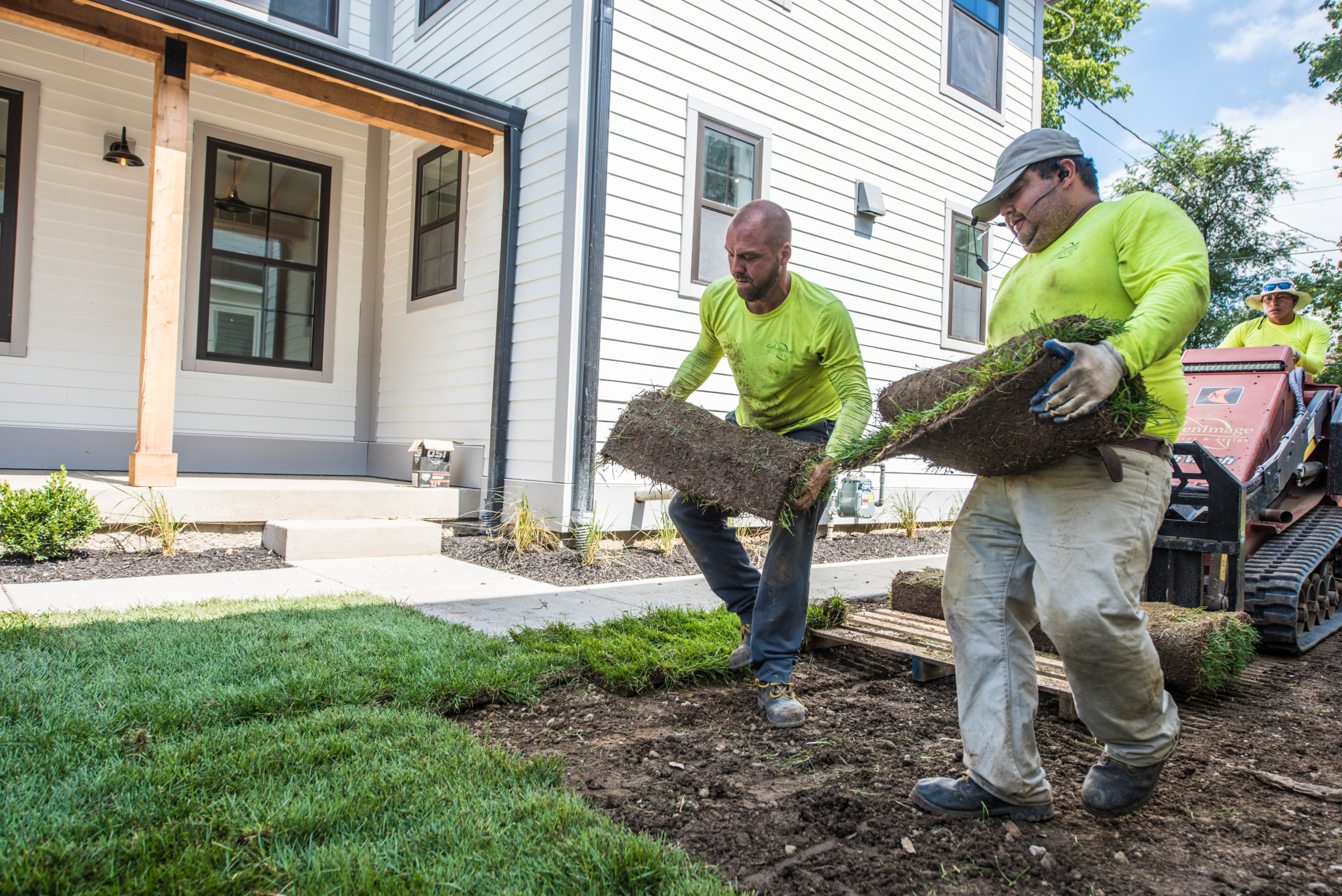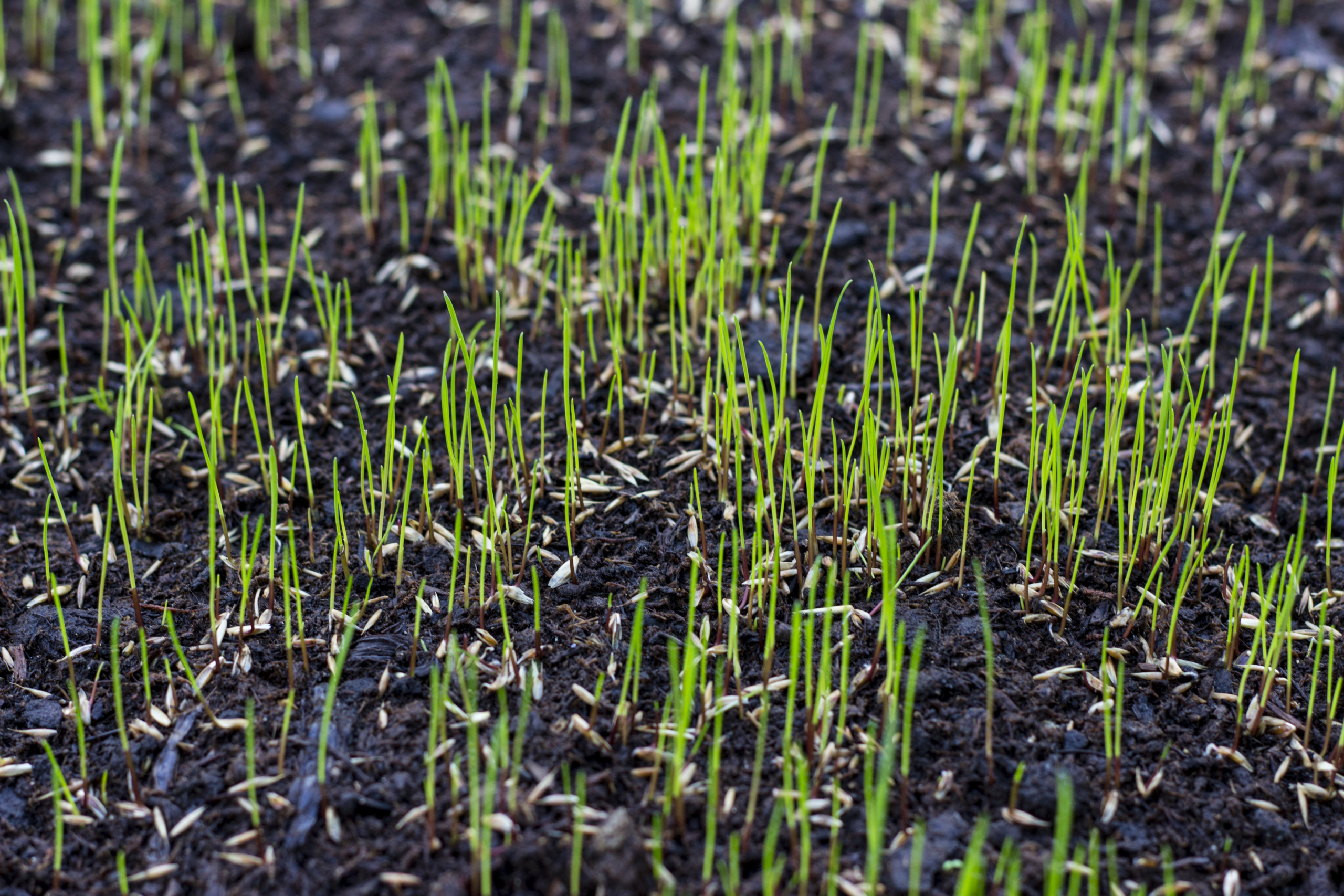You want a healthy, beautiful outdoor space that sets the scene for hours of family fun, backyard get-togethers, and relaxing evenings soaking in the scenery. The question is, what’s the best way to get there: seeding vs. sodding your lawn? Talk about turf wars!
Stop imagining a lush, thick, green oasis: make it happen with GreenImage. We’ll take you through the pros and cons of seeding and sodding your lawn so you can make the right call for your needs and goals.
A Quick Look at Seed and Sod
Are you establishing a lawn for your newly built home? Do you look out on your existing (scraggly, patchy, unhealthy) outdoor space and just want to start over? Or are you just looking to revive some patchy areas? Generally, there are two ways to do accomplish the mission:
- Seed: This one is fairly self-explanatory! You sow grass seed, which sprouts and grows into – hopefully – a golf course-worthy expanse of lawn.
- Sod: Imagine a big carpet of healthy green grass being rolled onto your lawn. This is sod, or mature turf that has been professionally cultivated.
Seeding vs. Seeding Your Lawn
This is not a case where one option is clearly the “right” way and the other is the “wrong” way. Both seed and sod are viable options – but there is a right way for your outdoor space. To get to the optimal solution, you need to weigh the benefits and drawbacks of each method and ask yourself some key questions, such as:
- How much time do I want to spend on this project?
- How much money do I want to spend?
- How long do I want to wait for a healthy – usable – lawn?
- When do I want to get started?
Let’s start by finding your answers.
Note: As you are making your decision, keep in mind that you will need to do some prep work before you start your project. You can’t just sprinkle some seeds on the ground or lay down some sod and call it a day! This part of the process can be labor intensive. Before you start, be sure to conduct a soil test, add any amendments you need, remove debris (rocks, roots, etc.), and smooth the ground as much as possible.
Seeding Your Lawn
Many landscaping experts agree that a well-seeded lawn is superior to a sodded lawn – with some caveats which we’ll
cover.
The Benefits of Seeding Your Lawn
- You have more grass varieties to explore. Grass seed is typically available in a much broader array of options. This enables you to select the right fit for your geography, light, and soil conditions. Further, you can choose grasses that offer higher levels of performance, lower levels of maintenance, drought resistant qualities, and/or enhanced resistance to pests.
- Your grass will grow a deeper root system. Your seed will grow in the same place they germinated and took root. This ensures that the grass can grow deep, healthy root systems from the get-go. Deep roots are key to a healthy lawn as they help deliver vital nutrients and they help your grass withstand “stressful conditions,” (e.g., drought). Additionally, you increase your lawn’s life and decrease fertilizer use.
- It is less expensive than sodding your lawn. The bottom line: seeding is more cost-friendly than sodding. Even the highest quality premium seed costs less than sod.
- It’s less labor-intensive. Installing sod is a job! First, you have to rip up the old sod; even if you rent a sod ripper, the machine itself is remarkably heavy and difficult to maneuver. With grass seed, you prepare the soil, and the hard part is done. You just use a spreader for even application, rake soil over the seed, and wait (though, for many, waiting is the hard part!).
Potential Drawbacks to Consider
Seed is a great solution for many, but be aware of some disadvantages:
- It takes longer to enjoy an established lawn. Speaking of waiting… Depending on the specific type of grass you select; you’re looking at 10 to 12 weeks of germination. Even light foot traffic can hurt your lawn. To handle heavy traffic (e.g., your kids running or a spirited game of fetch with the dog), you’ll have to wait one full growing season for a dense, mature surface.
- You have a narrower planting window. Again, depending on the specific grass, you will need to time seeding carefully. For example, if you go with a cool season variety, you’ll need to get the seed in in early fall. While you can plant in spring when temperatures are between 65 – 70℉, you increase the risk of weeds.
- It’s high maintenance. Seeds need sufficient water in order to germinate and grow into strong, established grass. You will likely need to add watering to your list of daily chores. But be sure to monitor conditions so you do not overwater. Enlisting professionals to maintain your newly seeded surface can save you untold time and ensure your grass gets the proper care and attention.
- You face the risk of erosion. There is a possibility that seed, and soil will wash away during heavy rains; until they are established it can be touch-and-go.
Sodding Your Lawn
Sod overcomes many of the obstacles associated with seed, but again, weigh the factors before you make your decision!
The Benefits of Sodding Your Lawn
- You get results now. When you install sod, you can look out and enjoy a beautiful, green lawn. Now, that’s
 satisfying! While it’s not ready for normal traffic, it looks
satisfying! While it’s not ready for normal traffic, it looks - Lawn establishment is fast. Ok, so how long does it take until you can run around, have a cookout, or otherwise enjoy your outdoor space? Just two or three weeks should do it; in this short time, your lawn should be well-established.
- You control erosion immediately. If you have a slope or another area that is prone to erosion, sod anchors the soil effectively and immediately.
- You have a larger window for installation. You can install sod anytime during the growing season, except in extreme heat. Look for the period of peak growth for the type of grass you’re purchasing and lay it down then. It’ll root faster.
- You’ll battle far fewer weeds. Today’s high-end sod has few or no weeds, so you won’t have to waste untold time battling these little invaders.
Sounds good, right? Sod does offer many benefits, but be aware of some drawbacks:
- It is more expensive. Foot for foot, sod costs more than seed. If you have a large expanse to cover, cost does come into play. Sod itself costs between $150 – $450 per pallet (or $0.35 – $0.85 per square foot). Installation costs between $1047 – $2906 and can be more if you need old grass removed, the shape of your lawn changed, or you have an irrigation system installed. If you DIY, you will need to factor in the cost of equipment – and your time.
- It’s a labor-intensive process. Removing old sod and laying new sod is hard work, and it takes a great deal of time. In addition to the “heavy lifting,” you will also need to move with precision to ensure seams are lined up properly.
- You have fewer grass options. Sod is grown by manufacturers, and they often offer a limited selection. You may not be able to get the grass that is right for your needs or goals.
- Different growing conditions can impact your lawn. Because sod is grown “off-site” and transferred to your lawn, it can take some time (and care) to transition. For example, most sod is grown in full sun. If you have a shady lawn, you could have difficulty keeping it healthy.
- You’ll need to get that sod down fast! When you purchase sod, it must be installed within 24 hours of harvest.
What’s Next? Maintenance for Seeded and Sod Lawns
After you’ve sown the seed or laid the sod, it is important that you take steps to properly maintain your new lawn. From careful watering and mowing to feeding and weeding, this can add hours to your weekend chore time. You want to make sure your investment pays off, and all your hard work yields gorgeous, green results.
GreenImage can handle your seeding, sodding, and ongoing maintenance needs, giving you back your time and energy – while maximizing the pride you take in your yard. Stop imagining; start bringing that picture-perfect outdoor space to life. Contact GreenImage for a free consultation or to develop your ideal yard and maintenance plan.



